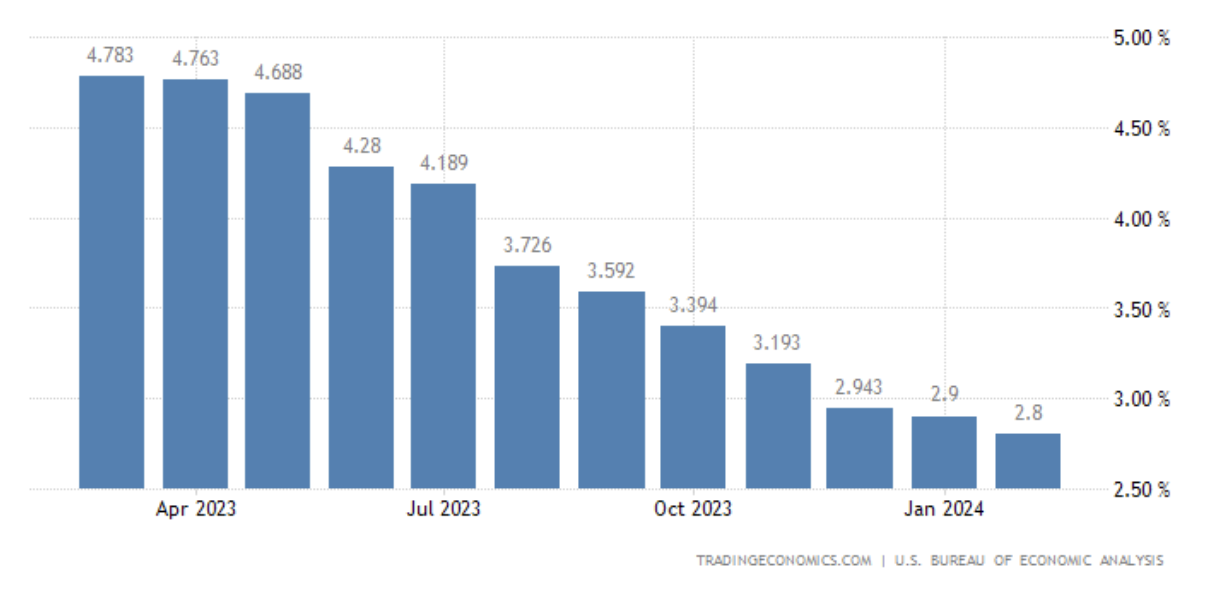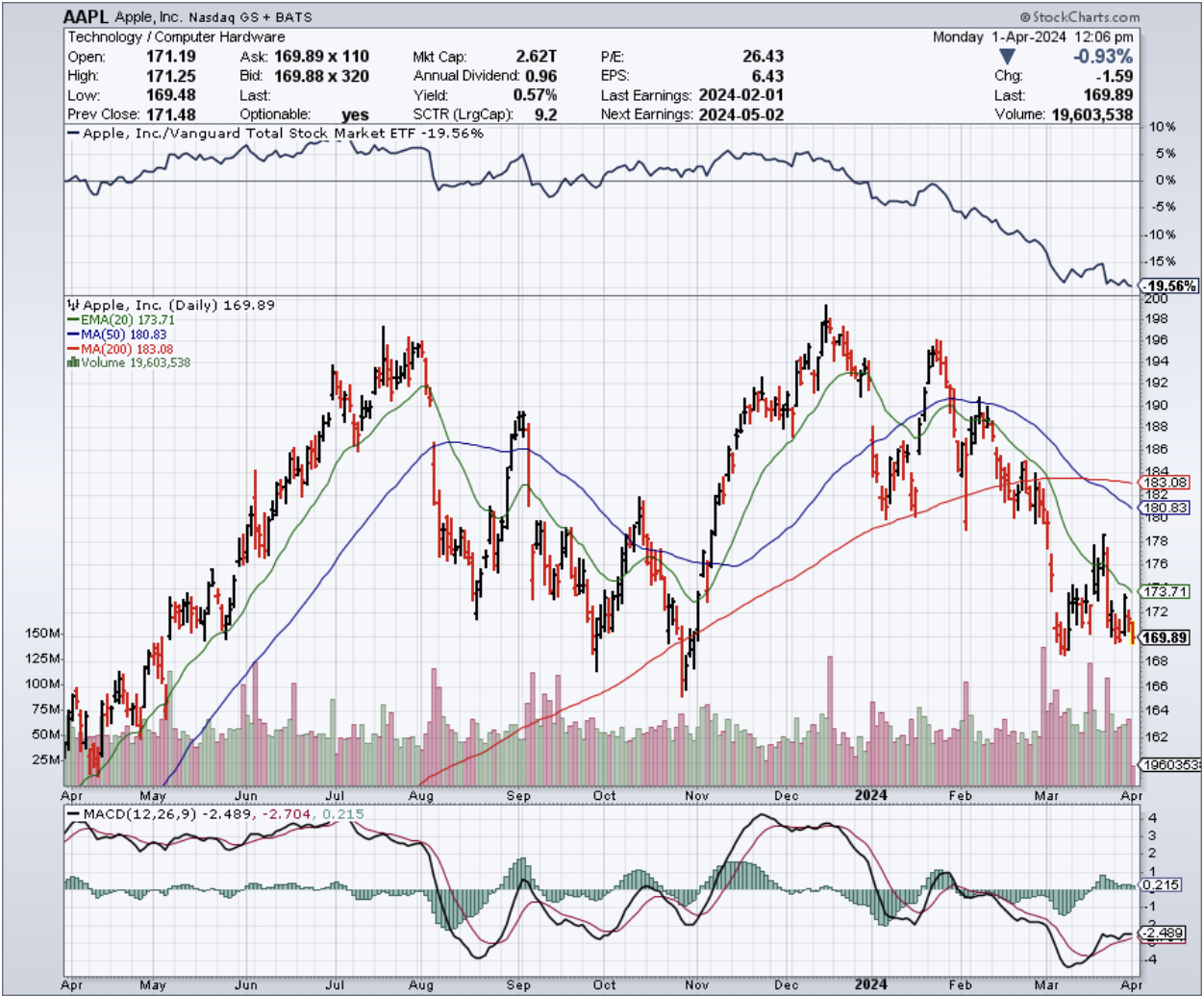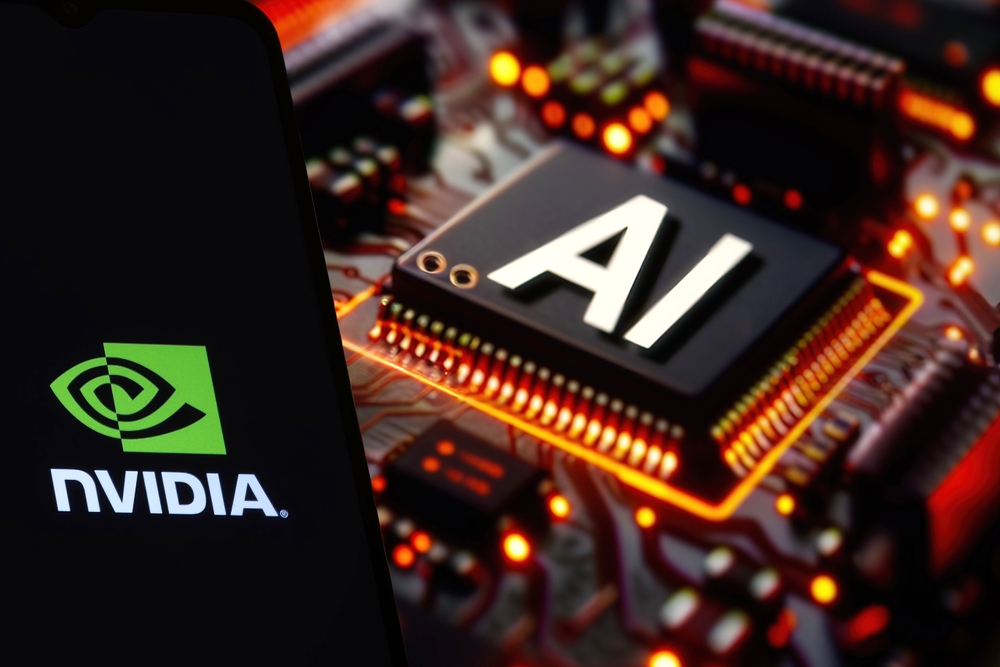Bulls Embrace New Market Leadership
The bullish narrative remains intact following Friday’s release of the Personal Consumption Expenditures (PCE) index, showing a gradual slowing in the Fed’s preferred inflation gauge, coupled with a short-term rebound in household spending. It was kind of the best-of-expectations report, but one that probably will hit some resistance with oil prices trading above $83/bbl, implying a spike in gas prices.

The S&P finished the quarter up 10%, the best quarterly performance in five years, and doing so with shares of Apple Inc. (AAPL) losing 11% year to date (YTD). Formerly the world’s most valuable company, Apple is beset with a fresh antitrust lawsuit by the Department of Justice (DOJ) that could extend for quite some time given the endless resources of that department. That, and the fact that Apple abandoned its autonomous driving project and succumbed to inviting Google’s AI Gemini large language model (LLM) onto their platform to fill in the void of offering a robust artificial intelligence (AI) feature, exposes some internal weaknesses. Toss in a contracting economy in China that accounts for 40% of iPhone sales and there is risk of the company entering its own lost decade.
There is a clear change of the guard within the mega-cap tech sector with NVIDIA Corp. (NVDA) as the new king. Normally, we as editors don’t single out stocks, but in the case of Apple, there is real downside risk to the shares if the price breaks $170 on volume. The next support level is $150. The chart of Apple shows a technical death cross where the 20-day and 50-day moving averages move down through the 200-day moving average, which almost always portends further downside risk.

Just ask the perma-bull pied pipers leading all the Tesla mice over the cliff as of late. Tesla shares were trading at $300 back in July and today trade at $180, a full 40% pullback as it becomes quite clear the consumer isn’t buying into the electric vehicle (EV) revolution nearly as fast as their utopian business model was laid out to be. Turns out, EVs don’t have the WOW factor as first thought.
I think one of the big differences between Apple and Tesla to that of NVIDIA is that the first two put out consumer products (iPhones and EVs), while NVIDIA produces chips that consumers never see and thus don’t have that personal experience with. Apple and Tesla are Business-To-Consumer companies, whereas NVIDIA is a Business-To-Business company whose technology is hard to grasp by most. It’s not like the experience of holding the iPhone in your hand or getting behind the wheel of a Model S. When is the last time anyone said in most social circles “Man, have you seen that latest H200 chip?”

Credit to Shutterstock
As long as the market makes the necessary adjustments to replace former All-Pro stocks with those that will take on the mantel of the crème-de-la-crème mega caps, then all will be fine with the overall bullish uptrend. The remaking of the Magnificent Seven was bound to happen, but not with the speed with which investors are having to consider repositioning their portfolios in the tsunami of the AI revolution.
According to UBS, the global demand for AI is projected to surge from $28 billion in 2022 to a staggering $300 billion by 2027. This exponential growth underscores the significance of AI in shaping the future. And here’s the best part. Most investors are still trying to figure out AI.
It is vitally important that investors don’t camp out on the original Magnificent Seven but look to a new Magnificent Seven. It was bound to happen. Just look at the poster child of the dot-com era, Cisco Systems Inc. (CSCO). Even NVIDIA has yet to achieve the lofty returns of that stock when it traded from $5 to $80 from mid-1998 to mid-2000, a 15-bagger, only to crash back to $10. While the stock has made its way back to $50 during the past 24 years, for investors who never sold, it’s been a painful ride.
Going forward, this past week, some $4 billion in cash left money markets that still total over $6 billion. Imagine when a portion of that money gets religion on the AI rollout and the stocks of companies that are dominating the space. It is becoming crystal clear that in addition to NVIDIA Inc., other big-cap tech companies are at the front end of the wealth-building AI trend, offering investors opportunities to cast a big-cap net over the AI revolution. It takes copious amounts of capital to lead in the AI space, therefore a blue-chip list of companies with rich balance sheets makes sense.
While there are large numbers of what are considered small-cap “pure plays” on AI, this is a capital-intensive transformational technology. Stick with the winners that the market has identified and truly believes in. It’s all in the charts. Stick with leading AI stocks trading in an upside breakout pattern. Don’t fight the tape. Don’t be clever. Just get in the way of the market, the analyst community and the fund flows. Professional managers will continue to bid up these and others just as blue-chip in nature as AI stocks because the capital investment in this space is legit and accelerating.
Consider using periods of selling pressure to acquire these names and others that fit the profile of market-blessed big-cap AI stocks. We’re in another golden age of technological revolution that can have a major positive impact on investors’ lives by being in the right stocks. Because we live in the time of Moore’s law, where advancements have an exponential impact on the industry, and because the implementation of AI is so capital intensive, the risk/reward profile for committing portfolio capital falls squarely on the market leaders.

